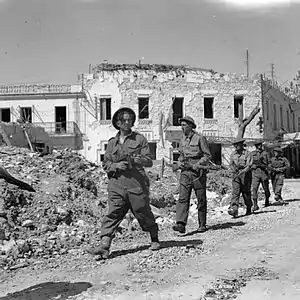Operations Vulcan and Strike
Operation Vulcan (22 April–6 May 1943)[1] and Operation Strike (6–12 May 1943)[2] were the final ground attack by the Allied forces against the Italian and German forces in Tunis,[3] Cape Bon, and Bizerte, the last Axis toeholds in North Africa, during the Tunisia Campaign of the Second World War.[1]
| Operations Vulcan and Strike | |||||||
|---|---|---|---|---|---|---|---|
| Part of the Tunisia Campaign of the Second World War | |||||||
 British troops advance through Bizerte in the final offensive, 8 May 1943. | |||||||
| |||||||
| Belligerents | |||||||
|
|
| ||||||
| Commanders and leaders | |||||||
|
|
| ||||||
| Casualties and losses | |||||||
| 240,000 captured | |||||||
Background
Generalfeldmarschall Erwin Rommel believed that the Axis position in Tunisia was untenable, and he had recommended the evacuation of all German troops to Italy, where he believed they could be more useful. His advice was rejected by Adolf Hitler. In April 1943, a major Allied air force effort (Operation Flax) had cut off Axis supplies to North Africa. U.S. II Corps, commanded by Major General Omar Nelson Bradley, surrounded the last defenders at Enfidaville, ending the Axis effort in North Africa. Operation Retribution and the control of the air and of the sea prevented any large-scale evacuation of Axis troops to Italy. The initial offensive was codenamed Vulcan.
Operations
Vulcan
The fighting was costly against German units in well-prepared and dug-in defences. In the advance on Tunis, the British 4th Infantry Division (British IX Corps, Lieutenant-General Brian Horrocks) was opposed by German paratroops (Fallschirmjager) of the elite Hermann Göring Parachute Division. At Cactus Far, the British infantry was faced by extensive defensive fire from well-concealed German paratroopers. Churchill tanks of the 12th Royal Tank Regiment (21st Tank Brigade), advanced without infantry support and the tanks were assaulted by the defenders using Molotov cocktails and sticky "teller" anti-tank mines. Twelve tanks were destroyed and in some cases, their crews were rescued from the burning wrecks by the Germans.
Strike
On 30 April it was realized that a revision was necessary to achieve success. The revised final phase of the assault on Tunis was codenamed Strike and launched six days later. On that day, the British First Army (Lieutenant-General Kenneth Anderson), took Tunis and American troops reached Bizerte. The German commander, General Hans-Jürgen von Arnim finally surrendered on 12 May.[4]
Aftermath
On 13 May, all remaining Axis forces in Tunisia, under the command of Marshal Giovanni Messe, surrendered unconditionally. Messe had, with Mussolini's approval, tried to negotiate an "honourable surrender" the previous day, but this had been rejected. Earlier in the morning he was promoted to the rank of field marshal but the Allies would not accept anything but an unconditional surrender and threatened to resume their attacks, which had been halted the day before. At 12:20 hours Messe gave the orders. He and the remaining German commander, Kurt von Liebenstein, surrendered late in the day.[5] By the close of the operation, nearly 240,000 German and Italian troops had been captured.
See also
References
Citations
- Chant 1986, "Vulcan", p. 326.
- Chant 1986, "Strike", pp. 266–67.
- Williams 1999, p. 105.
- "I Was There! - How Von Arnim Surrendered at Last - The War Illustrated". www.thewarillustrated.info. 11 June 1943. Retrieved 2017-07-30.
- Rolf 2015, p. 279.
Bibliography
- Chant, Christopher (1986). The Encyclopedia of Codenames of World War II. Routledge.CS1 maint: ref=harv (link)
- Rolf, David (2015). The Bloody Road to Tunis: Destruction of the Axis Forces in North Africa, November 1942–May 1943. Frontline Books.CS1 maint: ref=harv (link)
- Williams, Mary. H (1999). Special Studies: Chronology 1941–1945 United States Army in World War II. Washington, DC: Government Printing Office. ISBN 978-0-16-001876-3.